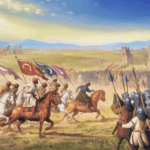
The year 1031 stands as a watershed in the history of medieval Spain, marking the definitive end of the Caliphate of Córdoba and the fragmentation of Muslim rule in the Iberian Peninsula. The collapse was not a sudden event, but the culmination of decades of internal strife, political intrigue, and social upheaval, known as the Fitna of al-Andalus. This epochal event forever altered the trajectory of Spanish history, ushering in an era of division, vulnerability, and ultimately, the Christian Reconquista.
The Golden Age of the Caliphate
At its zenith, the Caliphate of Córdoba was a beacon of prosperity, intellectual achievement, and architectural splendor. Founded in 929 by ʿAbd al-Rahmān III, the caliphate united al-Andalus under a single, powerful authority. Córdoba, its capital, became one of the largest and most sophisticated cities in Europe, renowned for its libraries, universities, and the breathtaking palace-city of Madinat az-Zahra. The caliphs – especially ʿAbd al-Rahmān III and his son al-Hakam II – presided over a society where Muslims, Christians, and Jews contributed to a flourishing culture that rivaled Baghdad in the east.

Seeds of Discord: The Road to Civil War
The seeds of the caliphate’s destruction were sown in its very success. The reliance on mercenary armies – Berbers from North Africa and Slavic slaves – created deep ethnic and social divisions within Muslim society. After the death of the powerful vizier Almanzor (al-Mansur) in 1002, the central authority weakened, and court intrigue intensified. His successors, lacking his charisma and military prowess, failed to maintain unity among the diverse factions vying for influence in Córdoba.
In 1009, a coup d’état led to the assassination of Abd al-Rahman Sanchuelo, Almanzor’s son, and the deposition of Caliph Hisham II al-Hakam. This event ignited the Fitna of al-Andalus—a brutal civil war that would rage for over two decades.
The Fitna of al-Andalus: Fratricide and Anarchy
The Fitna (Arabic for “trial” or “civil strife”) shattered the illusion of unity. Rival claimants to the caliphate emerged, each supported by different ethnic or regional factions: Berbers, Arabs, Slavs, and local Andalusians. In less than twenty years, ten different caliphates rose and fell, some lasting only months. The capital itself became a battleground, with the city of Córdoba and its suburbs repeatedly looted and devastated.
One of the most traumatic episodes was the siege of Córdoba by Berber mercenaries from 1009 to 1013. The city, once the pride of al-Andalus, was sacked, its Arab citizens massacred, and its monuments – such as the Medina Azahara – reduced to ruins. The violence did not spare the city’s Jewish community, many of whom were killed or forced to flee, including the prominent statesman Samuel ibn Naghrela. The destruction of Córdoba symbolized the irreversible decline of Umayyad authority.

The Final Act: Abolition of the Caliphate
By 1031, the caliphate was a shadow of its former self. The once-mighty institution, which had united Muslim Spain and projected power across the Mediterranean, now existed in name only. That year, the elders of Córdoba, led by Abn Hazm Ibn Jahwar, convened and formally abolished the caliphate. In its place, they established a governing council for the city, effectively acknowledging the end of central authority.
Across al-Andalus, towns and regions declared their independence, each ruled by its own emir or king. These new rulers became known as the “party kings” (mulūk al-ṭawā’if), and their realms as the Taifa kingdoms.
The Taifa Kingdoms: Fragmentation and Vulnerability
The fragmentation of al-Andalus into dozens of taifas brought a period of intense political and cultural dynamism, but also chronic instability. The largest and most influential taifas included Seville, Badajoz, Toledo, Zaragoza, and Granada. Each vied for supremacy, sometimes forming alliances, but more often engaging in bitter rivalry and warfare.
The taifas were often fabulously wealthy, drawing on the legacy of the caliphate’s prosperity. They became patrons of the arts, sponsoring poets, scientists, and artisans. The Taifa of Seville, for example, produced exquisite lusterware ceramics and became a center for intellectual life.
Yet, the taifas were politically weak. Lacking the military might and unity of the caliphate, they were unable to resist the growing power of the Christian kingdoms to the north. The Christian rulers – now organized as the kingdoms of León, Castile, Navarre, Aragon, and Portugal – took full advantage of Muslim disunity.

Christian Advance and the Reconquista
The collapse of the caliphate provided a golden opportunity for the Christian Reconquista. The Christian kingdoms, emboldened by the weakness of the taifas, launched a series of offensives to reclaim territory. They demanded tribute (parias) from the Muslim rulers, who often hired Christian mercenaries to fight their rivals.
The tide of war gradually shifted. In 1085, Alfonso VI of Castile captured Toledo, a major blow to Muslim Spain and a turning point in the Reconquista. The taifas, unable to withstand the Christian advance, eventually appealed for help from North African dynasties – the Almoravids and later the Almohads – who intervened but imposed their own harsh rule.
Cultural Legacy and Enduring Influence
Despite the political chaos, the legacy of al-Andalus continued to shape Spanish culture and European civilization. The taifas, for all their rivalry, remained centers of learning and artistic achievement. The transmission of Arabic science, philosophy, and the Hindu-Arabic numeral system to Europe occurred largely through al-Andalus in this period.
Córdoba’s libraries and scholars had laid the foundations for the later European Renaissance. The coexistence of Muslims, Christians, and Jews – however imperfect – fostered an environment where knowledge flourished. Even as the Reconquista advanced, the influence of Andalusi architecture, music, and cuisine persisted in Spanish life.
The abolition of the Caliphate of Córdoba in 1031 marked the end of an era of Muslim unity in Spain. The ensuing fragmentation into taifa kingdoms left al-Andalus vulnerable to conquest and forever altered the balance of power on the Iberian Peninsula. The collapse was not merely a political event, but a profound transformation that set the stage for centuries of conflict, cultural exchange, and the eventual Christian reconquest of Spain.




